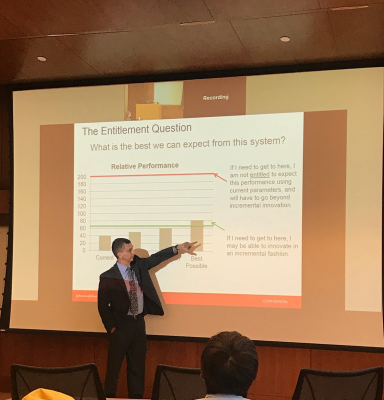On September 19th, Dr. Kenneth Creasy spoke at the Industry 4.0 and Manufacturing Ingenuity
course. The course, funded by CTNext, fosters innovation and entrepreneurship by providing students with exposure to emerging technologies in automation, cyber physical systems, and advanced manufacturing. The course is built upon seminars by invited industrial speakers to introduce cutting-edge technologies and challenges. 
Kenneth Creasy is the Senior Director of Manufacturing Technology and Innovation for Johnson & Johnson (J&J). In this role, he leads an enterprise-wide engineering organization supporting all segments of J&J. He focuses on identifying and developing disruptive technologies for the J&J Supply Chain. Prior to moving into his current role, Ken served as Director of Research and Development for the Neurosurgery businesses for Codman Neuro for 4 years and Director of Quality for Codman the previous 5 years. Ken has also served as a certified Master Black Belt in Six Sigma and Design Excellence for DePuySynthes and J&J. Prior to joining J&J, Ken had roles in R&D leadership at Honeywell and AlliedSignal. Ken started his professional career at Olin Corporation, with roles in R&D, Operations, Sales and Marketing. He is a member of the American Chemical Society (ACS) and is a Graduate Fellow of ACS. Ken has served as Chair of the Center for Process Analytical Chemistry and served as chair and keynote speaker for the International Forum on Process Analytical Chemistry in 2001. He also serves on the Industrial Advisory Boards for CESMII (Clean Energy Smart Manufacturing Innovation Institute) and ARMI (Advanced Regenerative Manufacturing Institute). Ken received his Ph.D. in Chemistry from the University of Connecticut and a BS in Chemistry and Biology from Hartwick College. He holds 12 US patents as well as numerous foreign patents. He has authored over 50 items comprised of book chapters, journal articles, critical reviews, and lectures.
In his talk entitled “Scouting & Incubating Technology for Healthcare Supply Chain”, Dr. Creasy focuses on innovation. Creasy stated, “we innovate because the current state is not good enough”. To innovate, first, one must identify the current issues. Identification may take place through interviews, economic evaluation, or brainstorming. After scenario planning, one must look to mega trends in healthcare in order to get a view for supply chain innovation. Once the impact on healthcare industries is noted, the impact on Johnson & Johnson products can be taken into consideration. There, the selection of technologies can take place, and new design and development ideas can be formed.
Creasy made it clear that there are different types of innovation. For example, half a million contact lenses are made per day at Johnson & Johnson. This happens through a process called incremental innovation. Incremental innovation is driven by improvement methodologies, such as Six Sigma, a process which requires one to gather the needs, test them, and see what is available, as well as what is maintained.
Johnson & Johnson aims to create the future through their vision of Industry 4.0. The vision involves the collaboration corridor, which can be divided into three categories. The first category is product design and development, and includes machine learning, cyber security, advanced analytics, big data, and software defined computing. The second category is production planning, which involves recipe management, digital thread, and advanced manufacturing systems. The final category is suppliers, which include the use of robots, 3D printing, advanced sensing, autonomous vehicles, and more.
Creasy went into detail about the innovation lifecycle, which is to adopt, ideate, discover, and evaluate. The adopt stage provides input for successful process and design validation or verification strategies. The ideate stage monitors emerging technologies through a variety of innovation networks. The discover stage provides support for concept development, and the evaluate stage provides quantitative evidence of process and/or product performance impact of adapting identified technologies.
Creasy finished his talk by giving his opinion on what further steps can be made in the future to improve innovation within Johnson & Johnson. He was welcomed with thoughtful student questions after the presentation.